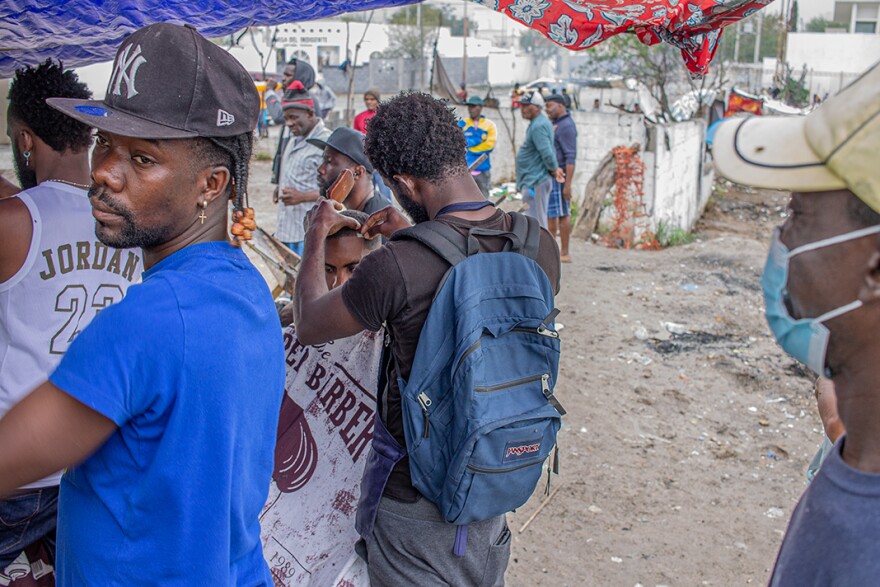Get TPR's best stories of the day and a jump start to the weekend with the 321 Newsletter — straight to your inbox every day. Sign up for it here.
In November, a federal judge ruled that the health policy known as Title 42 could no longer be used to expel migrants seeking asylum at the U.S. border after Dec. 21.
The policy was originally put in place to prevent the spread of COVID-19. However, it has since been described as having had “no basis in public health” by former CDC officials. The federal judge who blocked the policy described its use to prevent asylum as “arbitrary and capricious.”
South of the U.S. border in Reynosa, Nicodemus Pierre Lelouis said he’s heard little about what will change after Title 42 ends.
“I don’t really know much about Title 42,” he explained. “But I think it will be harder to get in. I don’t know what will happen.”
Lelouis escaped extreme instability in Haiti in 2017 to search for a better life. He came to the U.S. border after spending five years in Chile, not knowing much about the asylum process before he arrived in Reynosa three months ago.
“Not everybody who has a problem has a document to show them,” Lelouis said. U.S. law requires proof of persecution to be considered for asylum. That requirement will remain after Title 42 ends.

For migrants like Lelouis, who planned to seek asylum but not cross the border illegally, that requirement means that changes to Title 42 won’t matter.
He said he will not enter the U.S. “We have to wait,” he explained. He has lived with his family in an encampment. “We’ll have to wait for the system, to see how it’s going.”
The system Lelouis is waiting on could prove to be more difficult after Dec. 21. As Congress negotiates a possible extension of Title 42 this week, the Biden administration is looking at ways to restrict the flow of migrants.
RELATED | Title 42 migrant expulsions had no basis in public health, says former CDC deputy director
For example, the federal government could ask migrants to seek asylum in other countries before doing so in the U.S. This would place asylum even further out of reach for many.
This has meant that for some who originally came to Reynosa in search of a way into the U.S., the Mexican border city is becoming a home.

Migrant transplants are renting apartments and starting small street businesses. This gradual shift has been regularly reported in Mexican newspapers over the past year.
Finding a job is nearly impossible for undocumented foreigners in Mexico, but some local factories in Reynosa are finding ways to hire hundreds of migrant workers.
But for a 25 year old Haitian who would only identify himself as “Jackson,” the situation in Reynosa is precarious.
“Most of us here sleep on the street. I sleep on the street and just eat whatever I can,” Jackson said. “The shelter lets in the families first, but I’m alone so it’s harder for me. I have a friend who has a family. His mom cooks for me.”
Jackson avoided the question of where he has last traveled from or how long he’s been in Reynosa. However, when asked what he will do after Title 42, his answer came quickly.
“I’m waiting for that day to cross and ask for help,” Jackson said. “I need to eat. I need to work. There is nothing here for me.”

The possible change to Title 42 comes after an election season that saw conservatives lean on calls for heightened border security. America’s Voice, an immigrant rights advocacy, tracked more than 3,000 paid Republican campaigns that “employed anti-immigrant attacks” during the 2022 midterm election cycle.
That included 600 campaigns that falsely associated immigration with illicit drug trade. Those political ad campaigns ran even as data from Customs and Border Protection (CBP) has long shown that migrants are not the main source of smuggled narcotics.
For example, data from CBP showed that 95% of all fentanyl seized in Fiscal Year 2021 occurred at a port of entry, according to an analysis by the American Immigration Council. Most seizures involved passenger vehicles driven by U.S. citizens.
Despite the political rhetoric, three in four Americans “strongly or somewhat agree” that the U.S. should provide asylum to those escaping persecution or violence in their home countries. This is according to a new poll released on Tuesday by the U.S. Immigration Policy Center (USIPC) at the University of California, San Diego.

Jackson said he was temporarily staying a few blocks away from the Senda De Vida migrant shelter. His encampment was located inside an abandoned open structure.
“There are more like this everywhere, all around,” he said, gesturing to the city around him.
Earlier this year, Mexican officials dismantled a migrant encampment at a public plaza in the center of the city. Mexico's migration institute (INM) reported that 2,000 people were moved to a shelter.
There was no definitive count of the number of migrants in Reynosa right now. However, CNN reported one of the highest numbers in September when it quoted a local pastor who estimated 12,800 at the time.

Jackson explained that many of the migrants who were pushed out of the central plaza simply split up into smaller encampments. Some were hidden from public view to avoid any possible problems with Mexican officials.
Lelouis’ encampment was in another part of the city. He said he planned to return to the church service next Sunday at Senda De Vida, as he does every week.
“I know it was never easy to get into America,” he said. “But sometimes when God wants to do something, nobody knows. Sometimes God could just do something for us. We’re just waiting to see what’s going to happen.”



